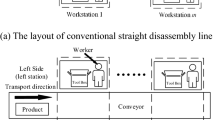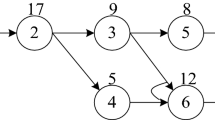Abstract
The disassembly line is the best way to deal with large-scale waste electrical and electronic equipment. Balancing of disassembly line is a hot and challenging problem in recent years. Given the uncertainty factors including corrosion and deformation of parts and components of waste products, this paper introduces the destructive mode and uncertainty disassembly time into the disassembly line and establishes a multi-objective disassembly line balancing model, considering partial destructive mode and U-shaped layout. The model aims to reduce the number of stations, balance the workload and reduce energy consumption while increasing the disassembly profit. A new multi-objective discrete flower pollination algorithm is proposed to solve the problem. Both task assignment and disassembly modes are considered in the encoding and decoding strategies of the flowers. Combining the discrete characteristics of the problem, the cross-pollination and self-pollination behaviors of the algorithm are redefined. The performance of the proposed algorithm is verified by solving two classical examples and by comparing with seven meta-heuristic algorithms. Then the proposed model and method are applied to a television disassembly line of a disassembly enterprise in China. The disassembly schemes of the proposed algorithm are superior to that of the five classical multi-objective algorithms. The results show that the proposed method can improve the performance of the disassembly line.











Similar content being viewed by others
References
Xia K, Gao L, Wang L, Li W, Li X, Ijomah W (2016) Service-oriented disassembly sequence planning for electrical and electronic equipment waste. Electron Commer Res Appl 20:59–68
Gungor A, Gupta SM (2002) Disassembly line in product recovery. Int J Prod Res 40(11):2569–2589
Gungor A, Gupta SM (2001) A solution approach to the disassembly line balancing problem in the presence of task failures. Int J Prod Res 39(7):1427–1467
McGovern SM, Gupta SM (2007) A balancing method and genetic algorithm for disassembly line balancing. Eur J Oper Res 179(3):692–708
Wang K, Li X, Gao L, Garg A (2019) Partial disassembly line balancing for energy consumption and profit under uncertainty. Robot Comput-Integr Manuf 59:235–251
Bentaha ML, Dolgui A, Battaia O, Riggs RJ, Hu J (2018) Profit-oriented partial disassembly line design: dealing with hazardous parts and task processing times uncertainty. Int J Prod Res 56(24):7220–7242
Deniz N, Ozcelik F (2019) An extended review on disassembly line balancing with bibliometric & social network and future study realization analysis. J Clean Prod 225:697–715
Song X, Zhou W, Pan X, Feng K (2014) Disassembly sequence planning for electro-mechanical products under a partial destructive mode. Assem Autom 34(1):106–114
Agrawal S, Tiwari MK (2008) A collaborative ant colony algorithm to stochastic mixed-model U-shaped disassembly line balancing and sequencing problem. Int J Prod Res 46(6):1405–1429
Wang K, Li X, Gao L (2019) A multi-objective discrete flower pollination algorithm for stochastic two-sided partial disassembly line balancing problem. Comput Ind Eng 130:634–649
Bentaha ML, Battaia O, Dolgui A (2015) An exact solution approach for disassembly line balancing problem under uncertainty of the task processing times. Int J Prod Res 53(6):1807–1818
Kalayci CB, Hancilar A, Gungor A, Gupta SM (2015) Multi-objective fuzzy disassembly line balancing using a hybrid discrete artificial bee colony algorithm. J Manuf Syst 37:672–682
Zhang Z, Wang K, Zhu L, Wang Y (2017) A Pareto improved artificial fish swarm algorithm for solving a multi-objective fuzzy disassembly line balancing problem. Expert Syst Appl 86:165–176
Ren Y, Zhang C, Zhao F, Tian G, Lin W, Meng L, Li H (2018) Disassembly line balancing problem using interdependent weights-based multi-criteria decision making and 2-optimal algorithm. J Clean Prod 174:1475–1486
McGovern SM, Gupta SM (2006) Ant colony optimization for disassembly sequencing with multiple objectives. Int J Adv Manuf Technol 30(5):481–496
Altekin FT, Kandiller L, Ozdemirel NE (2008) Profit-oriented disassembly-line balancing. Int J Prod Res 46(10):2675–2693
Ren Y, Yu D, Zhang C, Tian G, Meng L, Zhou X (2017) An improved gravitational search algorithm for profit-oriented partial disassembly line balancing problem. Int J Prod Res 55(24):7302–7316
Wang K, Li X, Gao L (2019) Modeling and optimization of multi-objective partial disassembly line balancing problem considering hazard and profit. J Clean Prod 211:115–133
McGovern SM, Gupta SM (2007) Combinatorial optimization analysis of the unary NP-complete disassembly line balancing problem. Int J Prod Res 45(18–19):4485–4511
Avikal S, Jain R, Mishra P (2014) A Kano model, AHP and M-TOPSIS method-based technique for disassembly line balancing under fuzzy environment. Appl Soft Comput 25:519–529
Zhang H, Cao X, Ho JKL, Chow TWS (2017) Object-level video advertising: an optimization framework. IEEE Trans Ind Inform 13(2):520–531
Zhang H, Llorca J, Davis CC, Milner SD (2012) Nature-inspired self-organization, control, and optimization in heterogeneous wireless networks. IEEE Trans Mob Comput 11(7):1207–1222
Yang X-S, Karamanoglu M, He X (2014) Flower pollination algorithm: A novel approach for multiobjective optimization. Eng Optim 46(9):1222–1237
Fouad A, Gao X-Z (2019) A novel modified flower pollination algorithm for global optimization. Neural Comput Appl 31(8):3875–3908
Zhou Y, Wang R, Zhao C, Luo Q, Metwally MA (2019) Discrete greedy flower pollination algorithm for spherical traveling salesman problem. Neural Comput Appl 31(7):2155–2170
Abdel-Basset M, El-Shahat D, El-Henawy I (2019) Solving 0-1 knapsack problem by binary flower pollination algorithm. Neural Comput Appl 31(9):5477–5495
Mittal N, Singh U, Salgotra R, Bansal M (2019) An energy-efficient stable clustering approach using fuzzy-enhanced flower pollination algorithm for WSNs. Neural Comput Appl. https://doi.org/10.1007/s00521-019-04251-4
Kalayci CB, Gupta SM (2013) Artificial bee colony algorithm for solving sequence-dependent disassembly line balancing problem. Expert Syst Appl 40(18):7231–7241
Kalayci CB, Gupta SM (2013) A particle swarm optimization algorithm with neighborhood-based mutation for sequence-dependent disassembly line balancing problem. Int J Adv Manuf Technol 69(1–4):197–209
Kalayci CB, Gupta SM (2013) Ant colony optimization for sequence-dependent disassembly line balancing problem. J Manuf Technol Manag 24(3):413–427
Kalayci CB, Gupta SM (2014) A tabu search algorithm for balancing a sequence-dependent disassembly line. Prod Plan Control 25(2):149–160
Deb K, Pratap A, Agarwal S, Meyarivan T (2002) A fast and elitist multiobjective genetic algorithm: NSGA-II. IEEE Trans Evol Comput 6(2):182–197
Ding L, Feng Y, Tan J, Gao Y (2010) A new multi-objective ant colony algorithm for solving the disassembly line balancing problem. Int J Adv Manuf Technol 48(5):761–771
Kalayci CB, Gupta SM (2013) Solving sequence-dependent disassembly line balancing problem using a hybrid genetic algorithm. In: Proceedings for the Northeast Region Decision Sciences Institute, pp 1119–1128
Kalayci CB, Gupta SM (2013) River formation dynamics approach for sequence-dependent disassembly line balancing problem. In: Gupta SM (ed) Reverse supply chains: issues and analysis. CRC Press, Boca Raton, FL, pp 289–312
Kalayci CB, Gupta SM (2013) Simulated annealing algorithm for solving sequence-dependent disassembly line balancing problem. IFAC Proc Vol 46(9):93–98
Deb K, Jain H (2014) An evolutionary many-objective optimization algorithm using reference-point-based nondominated sorting approach, part I: solving problems with box constraints. IEEE Trans Evol Comput 18(4):577–601
Li M, Yang S, Liu X (2014) Shift-based density estimation for Pareto-based algorithms in many-objective optimization. IEEE Trans Evol Comput 18(3):348–365
Wang R, Purshouse RC, Fleming PJ (2013) Preference-inspired coevolutionary algorithms for many-objective optimization. IEEE Trans Evol Comput 17(4):474–494
Yang S, Li M, Liu X, Zheng J (2013) A grid-based evolutionary algorithm for many-objective optimization. IEEE Trans Evol Comput 17(5):721–736
Bader J, Zitzler E (2011) HypE: An algorithm for fast hypervolume-based many-objective optimization. Evol Comput 19(1):45–76
Zitzler E, Thiele L (1999) Multiobjective evolutionary algorithms: a comparative case study and the strength Pareto approach. IEEE Trans Evol Comput 3(4):257–271
Zitzler E, Thiele L, Laumanns M, Fonseca CM, Fonseca VGd (2003) Performance assessment of multiobjective optimizers: an analysis and review. IEEE Trans Evol Comput 7(2):117–132
Acknowledgements
This study was funded by the National Natural Science Foundation of China (Grant No. 51721092), the Natural Science Foundation of Hubei Province (Grant No. 2018CFA078), and Program for HUST Academic Frontier Youth Team (Grant No. 2017QYTD04).
Author information
Authors and Affiliations
Corresponding author
Ethics declarations
Conflict of interest
The authors declare that they have no conflict of interest.
Additional information
Publisher's Note
Springer Nature remains neutral with regard to jurisdictional claims in published maps and institutional affiliations.
Rights and permissions
About this article
Cite this article
Wang, K., Gao, L. & Li, X. A multi-objective algorithm for U-shaped disassembly line balancing with partial destructive mode. Neural Comput & Applic 32, 12715–12736 (2020). https://doi.org/10.1007/s00521-020-04721-0
Received:
Accepted:
Published:
Issue Date:
DOI: https://doi.org/10.1007/s00521-020-04721-0




